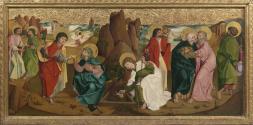Title: The Separation of the Apostles
Date: 1494
Medium: Oil on spruce panel
Dimensions:67.2 x 134.5 cm
Credit Line: Purchased, 1936
Object Number: NGI.978
DescriptionThe separation and subsequent travels of the apostles were recorded in the apocryphal Acts of the Apostles (1:8), written during the second and third centuries. The feast day of their separation enjoyed popularity in the visual arts between 1480 and 1510. This panel depicts the 12 apostles taking leave of one another as they embark upon their mission to spread the word of Christ to different parts of the world. The other side of the panel represents two angels holding Veronica’s veil, with an imprint of Christ’s face. The horizontal shape indicates that it originally formed the predella of an altarpiece. Placed at the base, it would have been the same width as the central section of the altarpiece.
Little is known about the artist who painted this panel but it is evident that he concentrated on the decorative aspects of the composition, particularly on the brightly coloured costumes of the apostles, the symmetrical landscape and the richly tooled, gold-leaf ornament that takes the place of the sky.
ProvenanceStift Admont, Admont, Austria, 1865-1935 (housed in neighbouring Schloss Rothelstein from 1865 until at least 1916); Galerie St. Lucas, Vienna; purchased, Galerie St. Lucas, Vienna, 5 February 1936
Exhibition HistoryGotische Malerei aus Österreich, Galerie St. Lucas, Vienna, 1935
Centenary Exhibition, National Gallery of Ireland, Dublin, October - December 1964
The Architecture of Ireland in Drawings & Paintings, National Gallery of Ireland, Dublin, 1975
Genius Without a Name, Wallraf-Richartz Museum & Fondation Corboud, Cologne, 20 May - 19 August 2001
Label TextThis panel depicts the twelve Apostles taking leave of one another as they embark upon their mission to spread the word of Christ to different parts of the world. The other side of the panel represents two angels holding Veronica’s veil. The horizontal shape indicates that it originally formed the predella of an altarpiece. Placed at the base, it would have been the same width as the central section of the altarpiece. Little is known about the artist who painted this panel, but it is evident that he concentrated on the decorative aspects of the composition.



